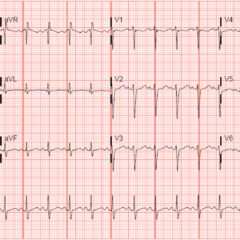Anticholinergic Toxicity in the Emergency Department
ABSTRACT:
Audience:
Emergency medicine residents, internal medicine residents, family medicine residents, community physicians, pediatricians, toxicology fellows
Introduction:
There are over 600 compounds which contain anticholinergic properties.1 Medications with anticholinergic properties include antihistamines, atropine, tricyclic antidepressants, antipsychotics, topical mydriatics, antispasmodics, sleep aids, and cold preparations.1-4 Plants that possess anticholinergic properties such as jimson weed, and street drugs cut with anticholinergics such as scopolamine are sources of accidental or intentional ingestion.1,2,4 Anticholinergic toxicity can cause a myriad of signs and symptoms, including agitation, seizures, hyperthermia, cardiac dysrhythmias, and death. Since poisoning from anticholinergic medications is frequently encountered in the emergency department, is it essential that emergency physicians be familiar with how to manage this toxidrome. This simulation case will allow the learner to evaluate and manage a patient presenting with anticholinergic toxicity.
Educational Objectives:
By the end of this simulation case, learners will be able to: 1) describe the classic clinical presentation of anticholinergic toxicity, 2) discuss common medications and substances that may lead to anticholinergic toxicity, 3) recognize the electrocardiogram (ECG) findings in anticholinergic toxicity that require specific therapy, and 4) review the management of anticholinergic toxicity.
Educational Methods:
This simulation is taught using a high- or moderate-fidelity manikin.
Research Methods:
The educational content was evaluated by the learners immediately after completion and debriefing of the scenario. This case was initially piloted with approximately twenty emergency medicine residents. The group was comprised of first, second-, and third-year residents from a three-year emergency medicine residency. The efficacy of the content was assessed by oral feedback.
Results:
Overall, the case was well received by learners, who felt it was useful and were engaged throughout the session. The overall feedback was positive and the case was well-received by learners.
Discussion:
This scenario was eventually tested on over 100 learners over the course of several years, and the overall feedback was positive. It was found to be effective when debriefing sessions using various debriefing techniques (such as advocacy/inquiry) were utilized to discuss both the learners’ performance in the case, as well as the debriefing pearls (located at the end of this manuscript).
Topics:
Anticholinergic toxicity, altered mental status, toxicology.

